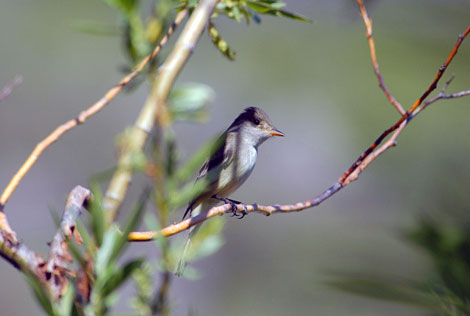

 Southwestern Willow Flycatcher. Photo by Dave Menke, U.S. Fish and Wildlife Service.
Southwestern Willow Flycatcher. Photo by Dave Menke, U.S. Fish and Wildlife Service.Southwestern Willow Flycatcher: Reclamation Works to Protect Native Species
The Southwestern Willow Flycatcher (Empidonax traillii extimus) is a small bird with a gray-green or brownish-olive upper body, white throat and pale breast and yellowish belly. It is one of four subspecies of willow flycatcher.
In the United States, the bird breeds in dense, moist riparian habitats at scattered, isolated locations in New Mexico, Arizona, southern California, southern Nevada, southern Utah, and southern Colorado. Historically, water management strategies that altered flows in the rivers and streams have led to the degradation and loss of dense riparian areas; this is the primary threat to willow flycatcher habitat. Now, with riparian areas limited and re-growth difficult due to changes in water flows, fire poses another significant risk. Human disturbances at nesting sites may also result in nest abandonment. These factors, as well as overgrazing by livestock, are the major causes of a population decline that resulted in the bird's designation as an endangered species in 1995.
In 1994, critical habitat along the lower Colorado River was set aside for endangered fish species. In response, the U.S. Bureau of Reclamation (USBR) and other federal, state, and tribal agencies formed a partnership to develop and implement the Lower Colorado Multi-Species Conservation Program (MSCP). The program is a coordinated, comprehensive, long-term multi-agency effort to conserve and work towards the recovery of endangered species, and protect and maintain wildlife habitat on the lower Colorado River.
In April 1997 a number of terms and conditions were outlined for implementation by Reclamation in order to specifically help preserve the Southwestern Willow Flycatcher. A five-year period of survey and monitoring of flycatcher habitat was required along the lower Colorado River. The overall objective is to achieve a level of population and regional distribution sufficient to insure the long-term survival of the species.
More Information:
http://sbsc.wr.usgs.gov/cprs/research/projects/swwf/cprsmain.asp
http://ecos.fws.gov/speciesProfile/profile/speciesProfile.action?spcode=B094
http://www.usbr.gov/lc/phoenix/reports/swwfc/swffea.pdf
http://www.lcrmscp.gov
